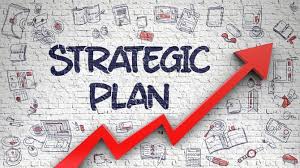Table of Contents
ToggleStrategic planning is an essential process for organizations seeking to achieve long-term goals and maintain competitiveness in an ever-changing environment. It involves setting clear objectives, analyzing internal and external factors, and devising a roadmap to guide decision-making and resource allocation. This article explores the concept of strategic, its components, benefits, and implementation strategies.
Understanding Strategic Planning

Strategic planning is a systematic process aimed at defining an organization’s direction and making decisions on allocating resources to pursue its goals. It differs from operational planning, which focuses on day-to-day activities. Strategic planning emphasizes the broader perspective, considering future trends, market dynamics, and the organization’s mission and vision.
This process typically involves key stakeholders, including executives, managers, and sometimes external consultants, to ensure a well-rounded and inclusive approach.
Key Components of Strategic Planning
- Mission and Vision Statements
At the heart of strategic planning lies the mission and vision statements. The mission defines the organization’s purpose and core values, while the vision outlines its aspirations for the future. Together, these statements provide a guiding framework for all strategic initiatives. - Situational Analysis
A thorough analysis of the organization’s current position is crucial. Tools such as SWOT (Strengths, Weaknesses, Opportunities, Threats) analysis and PESTEL (Political, Economic, Social, Technological, Environmental, and Legal) analysis help identify internal and external factors affecting the organization. - Goal Setting
Strategic goals are specific, measurable, achievable, relevant, and time-bound (SMART). These goals align with the mission and vision and serve as benchmarks for measuring success. - Strategy Development
This phase involves crafting strategies to achieve the defined goals. It includes identifying competitive advantages, exploring market opportunities, and addressing potential challenges. - Resource Allocation
Effective strategic planning ensures optimal use of resources, including finances, personnel, and technology. This step prioritizes initiatives that align with the organization’s objectives. - Performance Measurement
Key performance indicators (KPIs) are established to monitor progress and evaluate the success of the strategic plan. Regular assessments help identify areas for improvement.
The Benefits of Strategic Planning

- Enhanced Decision-Making
Strategic planning provides a structured framework for making informed decisions. It enables organizations to prioritize initiatives, allocate resources effectively, and respond to challenges proactively. - Improved Alignment
A well-crafted strategic plan ensures that all departments and teams work toward a common goal. This alignment fosters collaboration and reduces redundancies. - Increased Adaptability
In a rapidly changing business environment, strategic equips organizations with the agility to adapt. By anticipating trends and potential disruptions, companies can stay ahead of the curve. - Goal Achievement
Clear objectives and a defined roadmap improve the likelihood of achieving organizational goals. Strategic planning breaks down complex aspirations into manageable steps. - Stakeholder Confidence
A robust strategic plan demonstrates to stakeholders, including investors, employees, and customers, that the organization is committed to its vision and capable of delivering results.
Steps to Implement Strategic Planning
- Define the Purpose
Before embarking on strategic planning, clarify why it is necessary. Identify specific challenges or opportunities the organization aims to address. - Engage Stakeholders
Involving stakeholders from various levels of the organization ensures diverse perspectives and buy-in. This inclusivity fosters ownership and accountability. - Conduct Research
Gather data on internal capabilities and external factors. Use tools like market research, competitor analysis, and customer feedback to inform the planning process. - Develop the Plan
Create a comprehensive plan that outlines objectives, strategies, and resource allocation. Ensure the plan is realistic and adaptable to changing circumstances. - Communicate the Plan
Effectively communicate the strategic plan to all stakeholders. Transparency ensures everyone understands their role in achieving the organization’s goals. - Monitor Progress
Regularly review and assess progress using KPIs. Adapt the plan as needed to address emerging challenges or capitalize on new opportunities.
Challenges in Strategic Planning
- Resistance to Change
One of the most significant barriers to strategic planning is resistance yowestogel to change. Employees and stakeholders may be hesitant to adopt new strategies, fearing disruption or uncertainty. - Resource Constraints
Limited resources, including budget, time, or personnel, can hinder the implementation of a strategic plan. Prioritization and efficient resource allocation are vital. - Lack of Clarity
Ambiguity in goals or strategies can lead to confusion and inefficiency. Clear communication and well-defined objectives are essential. - Short-Term Focus
Organizations that prioritize immediate results over long-term planning may struggle to see the benefits of strategic. Balancing short-term needs with long-term goals is crucial.
Best Practices for Effective Strategic Planning

- Involve Diverse Perspectives
Engage employees from various levels and departments to provide a holistic view of the organization’s needs and opportunities. - Foster a Culture of Innovation
Encourage creativity and innovation throughout the strategic planning process. Innovative solutions can address challenges and create competitive advantages. - Focus on Flexibility
While having a structured plan is important, flexibility is equally critical. Be prepared to adjust strategies in response to unforeseen changes. - Leverage Technology
Modern tools and software can streamline the strategic planning process. Data analytics, project management platforms, and visualization tools enhance efficiency and accuracy. - Celebrate Milestones
Acknowledging progress and celebrating achievements boosts morale and motivates teams to stay committed to the strategic plan.
The Role of Leadership in Strategic Planning
Leadership plays a pivotal role in the success of strategic planning. Leaders set the tone, articulate the vision, and inspire teams to work toward common goals. Effective leaders also ensure accountability, provide resources, and address challenges promptly.
Empowering employees and fostering an environment of trust and collaboration are key leadership traits that enhance the strategic planning process.
Strategic Planning in the Modern World
In today’s globalized and technology-driven world, strategic planning has evolved to address complex challenges. Organizations must consider digital transformation, sustainability, and diversity when crafting their strategies.
The rise of artificial intelligence and big data has further revolutionized strategic. These technologies enable more accurate predictions, efficient resource allocation, and better decision-making.
Conclusion
Strategic planning is a cornerstone of organizational success. By defining a clear direction, aligning resources, and adapting to change, organizations can achieve their goals and thrive in a competitive landscape. Whether for a small business or a multinational corporation, strategic planning remains an indispensable tool for navigating the complexities of the modern world.

